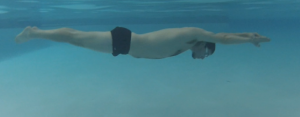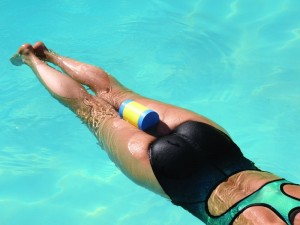Written by David Tatum, USAT Level 1 coach and IRONMAN All World Athlete
Let’s face it, swimming seems to the weakest of the three sports for the majority of triathletes. For whatever reason, many athletes come to the sport with a running or biking background and have to learn more about the swim than anything else.
As a kid, I grew up in the water. I spent my summers at the lake wakeboarding and waterskiing, I lifeguarded and taught swim lessons, and I learned how to scuba dive at the age of 12. In college, I also spent a significant amount of time surfing in San Diego. What I have learned in this sport is that I am the anomaly. I came to the sport as a strong swimmer, but had to really work on the bike and run. I want to share with you one secret that I learned intuitively in my aquatic experiences.
Are you ready?
Your “pull” is the most important part of your stroke!
Getting Streamline
While this seems simple let me explain how this should play out in your training. First, let’s recognize that many people talk about being streamlined in the water. What this means is that your body is horizontal in the water and creating the least amount of drag as possible. Because most triathlons are done with a wetsuit, which helps your body and hips to float, as triathletes, we don’t have to worry about this as much. Your wetsuit is going to put you on top of the water and also prevent your legs from dragging like they tend to in the pool.
It’s a Percentage Game
Next, understand that 10-15% of your race will be spent on the swim; the other 85-90% will be spent using your legs on the run and bike. Because of this, you should spend most of your energy on the swim using your upper body. Save your legs for the rest of the race; you’re going to need them. One of the fastest swimmers in triathlon, Andy Potts, says he doesn’t even use his feet until the last few hundred yards of the swim. Sheila Taormina, a triathlon world champion and Olympic swimming gold medalist, wrote an entire book proving that the “pull” is the most important part of the stroke. In her book, Sheila reminds swimmers of the 80/20 rule, which is a few aspects (20 percent) of anything we do that have the greatest impact (80 percent) on what we are trying to accomplish.
Do More Long Swims
From what I have experienced, most people swim short intervals and not enough long swims. They spend entirely too much time working on their kick and do not do enough long interval swimming. Don’t get me wrong, there is a time and place to do speed training and work on the shorter distances such as 25’s, 50’s, and 100’s. But if you want to simulate what you’re going to be doing on race day, you need to incorporate more long swims to your workouts. If all you ever do is short swims, you are not building the aerobic endurance needed for your race. In fact, if your training for a 70.3 or a full distance triathlon, you should have several swim workouts leading up to the race where you are swimming the full distance without stopping.
The Pull Buoy Should Be Your Best Friend
If your current swim is struggling, here is what I suggest: Spend 50% or more of your swim time with a pull buoy. A pull buoy helps simulate what a wetsuit does in the water. It allows you to elevate your hips and feet and swim downhill. When you use the swim buoy, you are not kicking and focusing all your effort on your upper body. This is the single best swim exercise that you can do as a triathlete! Along with this, incorporate more long swims and less shorter interval training, such as 100’s and 200’s. When swimming with a pull buoy, work on intervals of 500’s and 1,000’s.
Sample Workout:
- 500 easy warmup freestyle
- 1,000 pull with swim buoy
- 5×100 sprints with 15-30 seconds rest
- 1,000 pull with swim buoy
- 500 cool down easy freestyle
Total: 3,500
About the Author: David Tatum is a USAT Level 1 coach and IRONMAN All World Athlete. To learn more about David Tatum, visit www.tricoachtatum.com.




